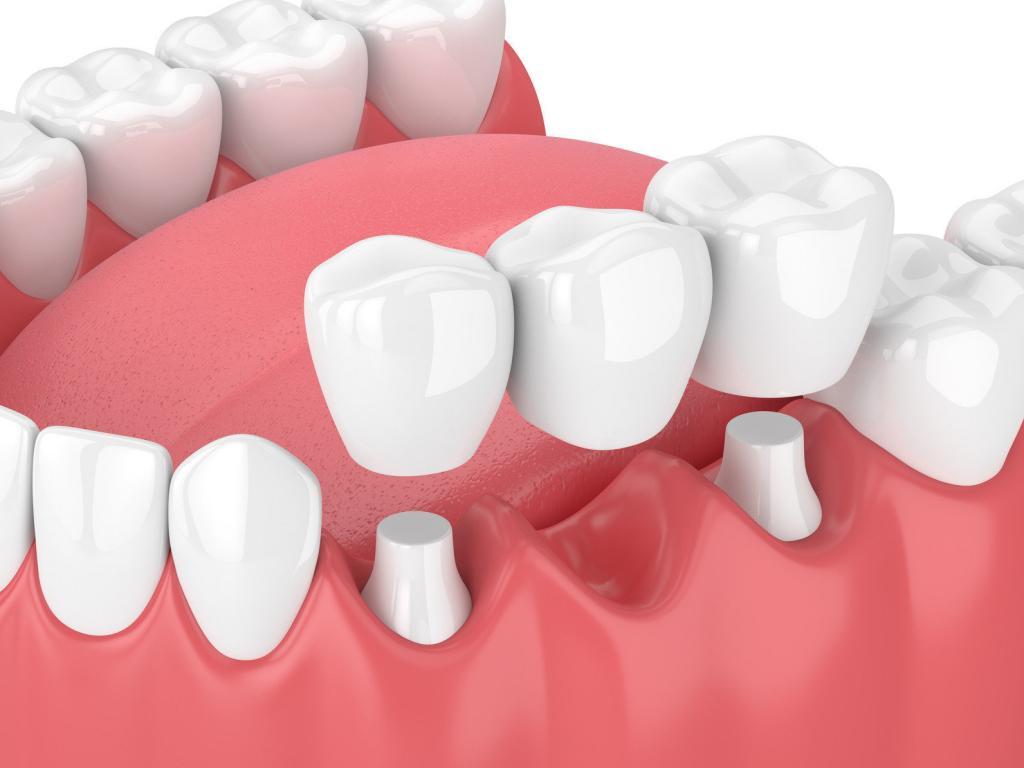Bridges
Dental bridges are a type of fixed prosthetic restoration the missing tooth or teeth lying next to each other. Each bridge consists of pillars, which are the teeth lying immediately adjacent to the gap it is intended to replace, and a span, which is the part between the pillars. The pillars and the span are attached to each other using abutments. Both the span and the pillars are called bridge members. The extent of the prosthetic restoration is determined by the number of members, the total number of members being the number of pillars + the number of restored missing teeth in the span.
Point terms are also used to define the extent of the bridge - the number of crowns, both pillar-based and restoring gaps in the dental arch, is considered a point. For example, when reconstructing a one-tooth gap where the span is based on two pillars, a three-arch (three-point) bridge is designed. The number of points in the bridge depends on both the length of the gap and the quality of the pillar teeth. When replacing large gaps in the dental arch, more than one pillar on each side is usually used. More pillars on each side are also decided upon for small gaps when the individual pillar teeth are not of sufficient quality and do not provide sufficient strength to withstand the additional load.

Nowadays, bridges are also made that are supported not only on crowns placed on the patient's own teeth, but also on dental implants. It is possible to support a bridge on both the crowned tooth and an implant. Prosthetic bridges not only provide a high level of aesthetics, but also allow the physiological distribution of masticatory forces - the occlusal forces are transferred thanks to the bridges through the periodontium of the underlying teeth to the alveolar process of the jawbone or jawbone, so that it is constantly stimulated to remodel and the process of bone loss is significantly slowed down compared to patients without prosthetic restoration. Bridges are always individually planned for each patient, taking into account the conditions in the mouth. An impression and a stenotic billet are taken from the patient, from which the shortness of the dental arches is determined.
- the presence of a sufficient number of pillars of good quality on which the bridge can be supported without the risk of their destruction by additional masticatory forces
- pillar teeth well embedded in the alveoli
- long roots of pillar teeth, favourable ratio in relation to crown length, 2:1 to 1:1
- long crown walls of pillar teeth to ensure adequate retention
- splinting of teeth affected by parodontopathies
- for filling a space that is too large, as there is then the possibility of damage to the tissues surrounding the pillar teeth by masticatory forces
- when occlusion between the planned bridge and the opposing teeth would only occur over a certain length of the bridge
- when the supporting teeth and surrounding tissues are unable to bear the additional load of a bridge
- in cases of significant alveolar atrophy, as some of the teeth in the bridge would have to be much longer than the natural ones, which would not provide a good aesthetic result.
- in intolerance of artificially created conditions by the gingival mucosa
Classic dental bridges
Traditional bridges are a common method of replacing partial missing teeth. Compared to adhesive bridges, they can prosthetic gaps in the dental arch of significant length. It is assumed that the length of the gap to be replaced by a bridge can be between one and four teeth.
- possibility of prosthetics for relatively long gaps in dental arches
- high durability and strength
- improving aesthetic and articulatory conditions
- possibility to create multi-part bridges
- can also be used for damaged teeth
- good functionality
- the need to grind the pillar teeth
- large pillar tissue defects - invasive treatment
- the possibility of damage to impacted teeth and the need for root canal treatment
- high price
As with crowns, a distinction is made between cast metal bridges, bridges faced with acrylic and ceramics, acrylic bridges - as temporary restorations, and all-ceramic bridges. The same materials are used for classic bridges as for crowns. The procedure for grinding pillar teeth is similar to that for crown preparation, except that with relatively long spans, larger step widths are used to ensure stability.
For more details on the treatments and price list, please visit the website: PROTETICS.
